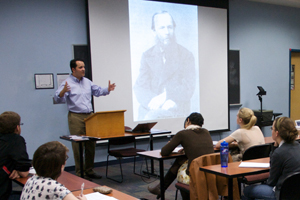Literature
Experiencing Dostoevsky's Russia

Since its founding last year, the Initiative for Russian Culture (IRC) has worked tirelessly to bring innovative courses and experiences in Russian art, history, literature, politics, and much more to AU and consortium students. This summer, with the IRC’s help, history professor and IRC associate director Anton Fedyashin will take ten students to Moscow and St. Petersburg to explore the Russia depicted in the works of legendary author Fyodor Dostoevsky.
The trip is the culmination of Fedyashin’s Dostoevsky’s Russia course in fall 2011. Over thirty AU students took this challenging and unique class. “This course was based on nothing but Dostoevsky’s own works,” says Fedyashin. “We placed Dostoevsky’s writing into its historical context.” Students spent considerable time on a variety of Dostoevsky’s novels including Crime and Punishment and the 900-page novel The Brothers Karamazov, as well as novellas. “Students seemed to most enjoy looking at Dostoevsky’s works in the context of the time period in which he conceived and wrote them.”
According to Fedyashin, Dostoevsky, who wrote from 1846 until his death in 1881, was extremely concerned with many of the major social issues of his day. “Dostoevsky has a reputation in the United States for being a very heavy, philosophical writer,” says Fedyashin. “This is true. But there’s another side to Dostoevsky in that he tailored his novels to the dominant social concerns of the era during which they were produced.” His 1866 novel, Crime and Punishment, addresses the nihilism and disregard for moral responsibility that swept the Russian youth during the 1860s through the novel’s protagonist, Rodion Raskolnikov, who creates and executes a plan to murder a pawnbroker. Raskolnikov believes that by using the money he takes from the pawnbroker to perform good deeds for society, he will counterbalance his crime. The Brothers Karamazov, Dostoevsky’s last novel, is an expression of Dostoevsky’s concern with the breakdown of the Russian family as it deals with the story of Fyodor Karamazov’s neglect of his three sons. But the novel also explores the morality of murdering a father figure in the context of the Russian revolutionaries’ hunt for Tsar Alexander II, which culminated with his assassination on March 1, 1881—just two months after Dostoevsky’s death.
Dostoevsky’s works are filled with contemporary references to the St. Petersburg in which he lived. “It is true that Dostoevsky was a great philosopher,” says Fedyashin. “But it is also true that taken out of context, his ideas lose some of their currency and vitality, because he was answering contemporary questions being asked in both Russia and Europe.”
While Dostoevsky spent the majority of his life, and set most of his novels, in St. Petersburg, he was born and raised in Moscow. According to Fedyashin, this was where Dostoevsky garnered his “old Moscovite Orthodox” way of viewing the world, largely through the influence of his very religious parents. This experience translated into the deep spirituality expressed in many of his novels, although he, too, went through a socialist-revolutionary stage in his youth.
In addition to visiting a variety of Russian cultural sites, including the Kremlin, the Russian Parliament building, and Mosfilm studios in Moscow and the Winter and Peterhof Palaces and the Mariinsky Opera in St. Petersburg, students will also have the opportunity to see the tiny Moscow apartment in which Dostoevsky grew up to understand the poverty in which he was raised. “This upbringing always made him very sympathetic to impoverished people,” says Fedyashin. “They constitute the bulk of the main characters in his novels.”
While in St. Petersburg, students will also explore the neighborhood in which Dostoevsky set Crime and Punishment. “That novel, more than any of his others, is tied to a very specific place,” says Fedyashin. “You can still walk the streets according to Dostoevsky’s descriptions and retrace the steps that Raskolnikov actually takes.”
“St. Petersburg is a character in these novels in itself,” he says. “St. Petersburg was, for him, an artificial, Europeanized city that was grafted onto Russia by Peter the Great.” According to Fedyashin, the author maintained a love-hate relationship with the city that is evident in almost all of his work. “He saw the city as corrupting many of his characters or reinforcing the problems they were already struggling with.” Similar to London and Paris during the same time period, extreme wealth located just adjacent to extreme poverty pervaded St. Petersburg. This disparity drove Dostoevsky to create many of his most notable characters.
Seeing St. Petersburg as it exists today will allow students to understand the contemporary relevance of many issues that Dostoevsky addressed in his work. “Even today, if you walk St. Petersburg’s Nevsky Avenue with its glitzy shops and wealth,” says Fedyashin, “and you compare that to the more impoverished neighborhoods, you can see that this disparity still exists.”
The trip will take place July 1–10 and there have already been over 25 applicants for just ten spaces on the trip from both AU and other consortium schools. Students have the option to take the trip as a three-credit course or for a non-credit fee, and all participants will be required to read Crime and Punishment and complete a paper examining the role that St. Petersburg plays as a character in the novel. The application deadline is March 10. Next year, Fedyashin hopes to launch a similar course and trip featuring the work of Russian writer Leo Tolstoy.
Students from all consortium universities interested in going on this trip may apply by March 10.
